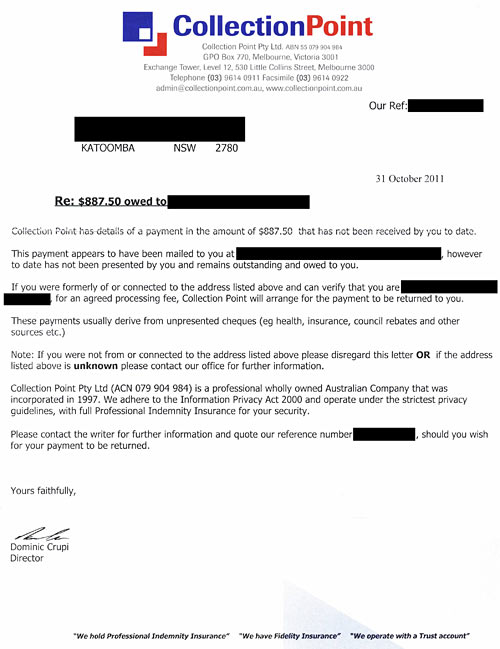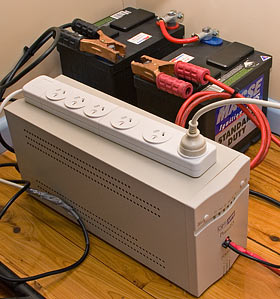I love it when I don't have to go looking for an interestingly fishy business proposal, because some obliging organisation mails it to me.
(It's even better than unsolicited crank e-mail.)
Strictly speaking, this one wasn't actually mailed to me, but to my partner Anne. It wasn't precisely aimed at her, either; they had our old address right, but if the recipient's name had been Norma Jeane Baker, the letter would have been addressed to Jeane Norma Baker.
So anyway, it's from an outfit called "CollectionPoint", and they're pleased to tell Anne that there's $AU887.50 waiting for her in an undisclosed location. Apparently CollectionPoint do debt recovery too, for a fee of 25% plus GST. They don't quote a fee for this other kind of money recovery, but I think it's safe to say it's not small.
We're not exactly rolling in dough at the moment, so a forgotten nest-egg could be quite handy.
(Do send me some money if you feel like it. We're hardly on the bread-line, though; I assure you that the lights will stay on, the cats will still get their little tins of fancy fish and the freeloading cockatoos will get their seed without your kind assistance.)
The questions that immediately occurred to me were, of course, "does this money actually exist?", and "is this outfit charging a fee for something you can do quite easily yourself?"
The answers to these questions are surprising and unsurprising, respectively.
"Unclaimed money" has been a scam-artist favourite for a long, long time. Unexpected inheritances. Prizes in lotteries you never even entered. A permutation in which the money may not actually strictly speaking be yours, but a morally upstanding person says you can still get hold of it, for a price. Some sort of purported government involvement. The list goes on.
The unclaimed-money business has even spawned meta-scams, in which the sucker pays for an information pack or franchise opportunity or something so they can start a work-at-home business finding unclaimed judicial judgements, or whatever, and creaming off a fat commission.
But CollectionPoint actually are telling us about money we really can claim. We'll claim it as soon as we can make a big enough pile of ID documents.
CollectionPoint are also, however, offering to take people's money to help them do something that is not actually difficult to do - or at least not significantly more difficult to do - by yourself.
The Australian government has a site called "Moneysmart" that'll point you at various unclaimed-money searches. Anne found the money CollectionPoint are talking about via the NSW Office of State Revenue site. Which is presumably the same way CollectionPoint found it.
So CollectionPoint do provide a helpful service. They alert you to the existence of money you probably can actually collect. And then you can throw the CollectionPoint letter away and go and collect your money the free way. CollectionPoint do not appear to be breaking any laws.
Well, they're not breaking any laws right now, anyway. The Australian Government's Department of Veterans' Affairs are happy to list CollectionPoint on their scam information page - apparently CollectionPoint sent letters to war widows claiming to be acting on behalf of that Department. And it's not hard to find other people talking about CollectionPoint in not-entirely-complimentary terms.
CollectionPoint come off pretty well in this blog post, for instance, until several allegedly separate people show up in the comments, all loudly defending CollectionPoint and all suffering from a suspiciously similar inability to construct a sentence, or in many cases even a word.
CollectionPoint also score themselves a mention in this Age article; apparently CollectionPoint have sent out follow-up letters implying - but not exactly actionably saying - that if you don't use their services, you'll miss out on the money altogether.
A commenter here says that after a CollectionPoint letter put him onto some money he could claim, and he claimed it himself without using CollectionPoint's services, CollectionPoint sent him a bill.
This bloke says CollectionPoint offered to collect $500 owing to him for a mere $160 - a 32% fee. Even Today Tonight doesn't like them.
Oh, and according (PDF) to the Consumer Action Law Centre, CollectionPoint charged a 25% fee for recovering some unclaimed superannuation money for an elderly client after he provided them with the identifying information he could have used to get the money back for free. But then CollectionPoint jacked up the 25% fee by adding another 10% GST charge (so 27.5%, altogether). The Consumer Action Law Centre took the case to court, and (another PDF) the Victorian Civil Administration Tribunal decided that CollectionPoint were indeed gouging their client, and reduced the fee payable to CollectionPoint by 45%.
The funny part, though, was that in response to this lawsuit CollectionPoint filed their own, in the same court, against the Consumer Action Law Centre's lawyers. They alleged "misleading and deceptive conduct" and an obscure kind of defamation, "injurious falsehood", which is becoming less obscure after recent reforms to defamation law in Australia.
In my non-lawyerly estimation, I think the result of this counter-suit can fairly be described as "widespread puzzlement".
So anyway, we're getting our eight hundred and something bucks.
CollectionPoint won't see a penny of it.



